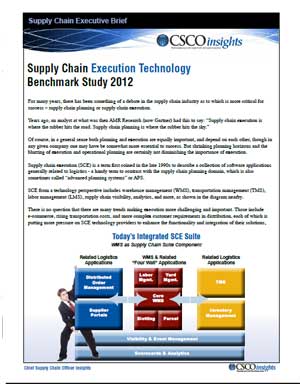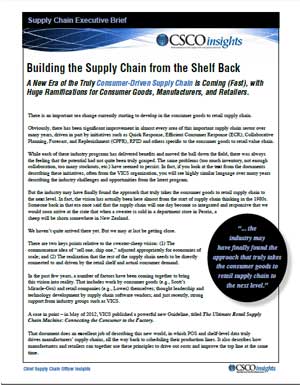 |
December 6, 2012 - Supply Chain Newsletter |
 |
FEATURED SPONSOR - MHIA |
 |
One show, 800 exhibitors, infinite possibilities |
 |
|
||||||||||||||||||||||||||||||||||||||||||||||||
Dr. John Langley of Penn State: Unplugged
|
|||||||||||||||||||||||||||||||||||||||||||||||||
| GILMORE SAYS: |
"Langley says it is critical to define and measure supply chain effectiveness through the eyes of the customer, and not just your own internal perspectives and measures." WHAT DO YOU SAY? |
With all that, John seemed like a great candidate for one of our "unplugged" series of interviews, in which I cover a lot of territory with leading supply chain industry thinkers. In truth, with all we have going on here, it is been too long since I did one of these, but I promise to ramp the pace back up in 2013.
I had a great hour-long conversation with John earlier this week, which I am confident you will find interesting. As usual I will provide highlights here and a complete transcript a week or two down the road.
I knew John had undergraduate, master's and doctoral degrees all from Penn State, but I did not know the undergrad was in mathematics and the master's an MBA with a finance concentration. After that, he tells me he wanted to do a PhD program, and decided that the logistics field looked quite promising, and presented an opportunity to well use some of the quantitative skills he had gained in his earlier education. He says even then, he could sense that logistics effectiveness was going to be a growing component of overall business success, and that he could therefore be involved in a lot of practical applications as well.
That PhD led to a prominent, almost 30-year career at the University of Tennessee, a high profile change to Georgia Tech for nine years, and now the move back home to PSU.
6th Annual Gartner-SCDigest Supply Chain Study
Complimentary Gartner Reports for Respondents
So what are the most prominent changes Langley sees from what was still really the formative days of the discipline of logistics when he started his career through to today's full supply chain era?
He started by noting that of course the capabilities and role of technology in supply chain today has changed dramatically, but added that while we all know that, too often companies today don't tend to focus heavily enough on how well they are actually leveraging and managing that technology versus their competitors.
That comment made me wonder whether we need some kind of better gauge or metric for how well companies are in fact managing their supply chain technology. I am not aware of any. I am going to think about that.
He also noted that perhaps the best change over the last couple of decades is that supply chain now provides a more clear path to senior leadership in a company, and in some cases (such as Walmart's Lee Scott) a route to the CEO job itself.
"It wasn't that long ago that if you were in a functional logistics area such as distribution or transportation, you weren't really likely to be tapped for higher level corporate responsibility," Langley said. "Now, many are putting their best and brightest employees into supply chain roles."
Relatedly, he noted that today "business strategies and supply chain strategies are often thought of in the same sentence. This is a huge change from not long ago."
I was curious whether - given all the progress that has been made in supply chain practice and technology - does Langley think we are anywhere near a sort of performance plateau, where the opportunities for improvement will be harder and harder to find?
"I don't think so - and the reason is growing supply chain complexity," Langley says. "That is the biggest challenge most companies are facing today."
 Langley observes that most of this complexity is coming from the external environment, but that in other cases the level of complexity is self-inflicted, but in mostly a good way, as companies master a certain set of capabilities and skills, but then reach for the next challenge, which turns the complexity dial up yet again.
Langley observes that most of this complexity is coming from the external environment, but that in other cases the level of complexity is self-inflicted, but in mostly a good way, as companies master a certain set of capabilities and skills, but then reach for the next challenge, which turns the complexity dial up yet again.
"We still don't have a really a robust way to really measure supply chain complexity though," he noted.
On a similar vein, given all the companies Langley has and continues to work with on supply chain issues, I wanted his thoughts on whether he sees a sort of convergence of supply chain effectiveness across enterprises, or if there are still big gaps between companies, as I believe.
First, he observed, it is critical to define and measure supply chain effectiveness through the eyes of the customer, and not just your own internal perspectives and measures. And there, of course, price plays a critical role, with supply chain effectiveness of course impacting price and/or margins.
"The big change today I think is that customers in the past would often pay a higher price for superior levels of service, but that is mostly gone today," Langley said. "What I find today is that supply chain leaders are moving the entire curve and thus being able to deliver superior service at a lower cost and thus lower price or higher margin."
He also says there are important differences in the level of innovation and value-added services companies offer, and that many supply chain leaders today that have nearly mastered the "effectiveness" aspects of the supply chain (subject to on-going changes in the environment) have been turning their attention to these areas. Laggard supply chains still struggling with the blocking and tackling are less likely to innovate, Langley says. That innovation will of necessity usually involve higher levels of collaboration, which is what many leaders see as the source of the next round of supply chain improvements.
He also noted that "today, given what Supply Chain Digest and others are doing, what it takes to have an effective supply chain isn't such a deep secret anymore. Yet, many companies still can't make it happen. Why is that?"
Before I run out of room here, I wanted to get to some comments from Langley on 3Pls and shippers, given his long history on this topic, including heading the annual 3PL study mentioned above, slots on a couple of 3PL boards, and more.
Let's start with a fundamental question: should most companies do more logistics outsourcing? Not necessarily, Langley says, but too often companies may not be really ask or answer the question effectively.
Companies should do the right (i.e., objective) analysis and come up with the path that is best for them, but Langley says that in annual study, when companies are asked why they don't outsource or don't outsource more, "they will often say that logistics is a core competency, or it is too important for them to outsource - I have to wonder those answers are more excuses than the results of careful analysis studying the opportunities and benefits from outsourcing."
He adds that when doing the analysis, it is critical that companies clearly determine the decision criteria upfront to avoid having bias enter into the process.
Is there a risk of creating a slippery slope, where companies outsource so much for so long they lose the internal expertise almost entirely, and could never bring it back again if they wanted?
That is a "legitimate concern," Langley says, and should be factored into the risk analysis, but notes that "if you talk to a number of organizations, they will tell you they have actually gained more control of logistics via outsourcing, not the opposite."
I covered just a fraction of our discussion - look for the full transcript soon, which will include more discussion around outsourcing, why academic research in supply chain too often isn't very practical, and more.
John Langley has been a great asset to the supply chain for a long time, and we hope for a long time to come.
What's your reaction to Gilmore's interview with John Langley? Anywhere you especially agree or disagree with his perspective? Let us know your thoughts at the Feedback button below.
![]()
| View Web/Printable Version of this Page |
|
|
|
YOUR FEEDBACK
Some feedback this week on our recent First Thoughts column on the supply chain challenges of multi-channel commerce, including our feedback of the week from Steve Murray of Supply Chain Visions.
We also have a few brief letters with some nice things to say about the inaugural Supply Chain Network by Design column by our new expert columnist Mike Watson of Northwestern University. His first column was on "Advanced Analytics."
Feedback of the Week: Multi-Channel Commerce Challenges
Thanks for another thought provoking set of questions about an evolving environment.
If we think about retail sales with the consumer at one end and the manufacturer at the other, the shortest and simplest approach would appear to be B2C direct from the end of the manufacturing line. However, appearances can be deceiving, particularly when long distances are involved. This is why we have distribution networks. And manufacturers are far more capable of building pallets to ship in full truckloads than they are to send single retail units of multiple SKUs to a consumer address. The driving force is the consumer, and today the consumer wants and expects extremely rapid delivery. Even same day delivery. And, they expect discounted pricing on-line and free shipping to boot. If that wasn't enough they want to be able to go to a brick and mortar store to examine the product prior to purchase, then after making on on-line purchase take the product back to a fixed location for credit if they decide they don't want it. How in the world does the B&M retailer get compensated for their part in this deal? Lots to think about. Not only how the dot-com channel can make money, but how the traditional stores can as well. Somebody certainly needs to come up with an tenable solution. Steve Murray |
||
| More on Multi-Channel: | ||
Some of the comments in the articlefrom "experts' reflect the failure to recognize that there is still some difference between e- or m-commerce buyers and brick-and-mortar buyers. Of course the best buyers move between these categories, but they between them because of different expectations of each channel. For example, most buyers who want same-day access to a product are willing to go to the store themselves ... I expect demand for same day delivery of online orders to remain limited both overall and limited to very high density cities, such as NYC. But further, the staff which operates B2B and B2C warehouses continue to need help recognizing the differences between serving these two market segments. Sharing inventory is potentially valuable, but after that the functions between to differ widely. Operators need to both recognize and understand those differences. Many, if not most, still don't. It's important to provide a very low cost shipping method - low cost and slow. Customer should pay for speed.
Direct Commericial Advisors
|
||
The buzzword in today's retail space is Omnichannel. Check out Retailigence.com for online search to offline purchase (O2O) capabilities that retailers and mobile apps developers are subscribing to their "data as a service" and location based marketing. Amazon does real time order and inventory optimization throughout the day and treats their shipping lanes as almost a fixed cost. The more volume per lane the greater the "margin per box." Wal*Mart is the sleeping giant in Internet sales and is about to wake up. They are the only "long tail" bricks and mortar retailer that can compete with Amazon on a global basis. Meijer has been very successful with its omnichannel strategy; but, they are still pretty regional on the bricks and mortar side. They still have the most optimal cost structure in the industry. The rumor is that Amazon is going to open some retail outlets; buy, they won't be physical long tail stores. They will be more trendy in all likelihood; but, they will have difficulty competing in the omnichannel space. In the more traditional space, Macy's and Nordstrom's are competing quite well in omnichannel. It will be interesting to see if Walmart will go into more upscale categories as it beefs up its Internet presence. Traditionally, those shoppers don't shop at Wal*Mart because they can afford not to. Amazon, Nordstrom, Macy's, and others show upscale shoppers go online. With Walmart.com, the shopper doesn't physically have to go into the store. And, don't count out BestBuy... some innovative O2O and same day delivery strategies are forthcoming.
Rich Sherman
|
||
| On Advanced Analytics in the Supply Chain: | ||
Nice final thoughts and I agree that analytics "is the ability to use data to make better decisions." Another interesting aspect that we can draw from this (apart from what the data is telling us) is what the data is not telling us. In fact, it is the "not-telling" that contributes to a greater degree of complexity. Koh Niak Wu, Ph.D.
|
||
| Great article Mike. It may be too late to worry about "Analytics" becoming a buzzword. Just like "analysis", "analyst" or "optimize" it's become part of the general vocabulary and has lost much of it's clarity. I think I moved to calling what I do "Advanced Analytics" as a way of highlighting that analytics can't all be done in Excel.
For the people buying such software and services this is a crucial thing to understand - just because it says analytics on the box does not mean you will get anything more than simple reporting when you use it. In fact, if my experience is at all representative, if its says "analytics" there is an excellent chance you will find nothing beyond reporting and perhaps visualization/alerting tools. If what you need is a predictive model, you had better understand what constitutes "predictive analytics". Personally I tend to use the "What happened?", "What if?" and What's Best" categories to explain different sorts of analytics but perhaps it's time for me to make a change. Andrew Gibson |
||
Concise and on point without hyperbole! Thanks, Dr. Watson!
|
SUPPLY CHAIN TRIVIA ANSWER
Q: How many cars on average does a class 1 US train carry?
A: Well, this is only from Union Pacific, but in Q3 its trains carried an average of 87 regular rail cars and 176 intermodal containers.
| © SupplyChainDigest™ 2003-2012. All Rights Reserved. SupplyChainDigest PO Box 714 Springboro, Ohio 45066 |
POWERED BY: XDIMENSION
|









